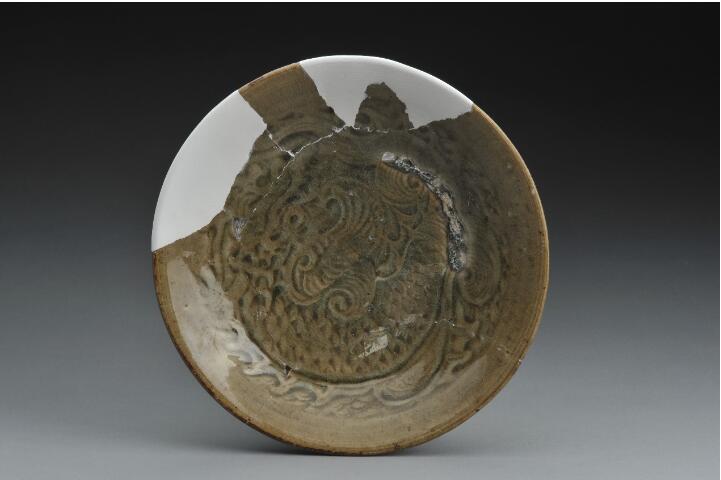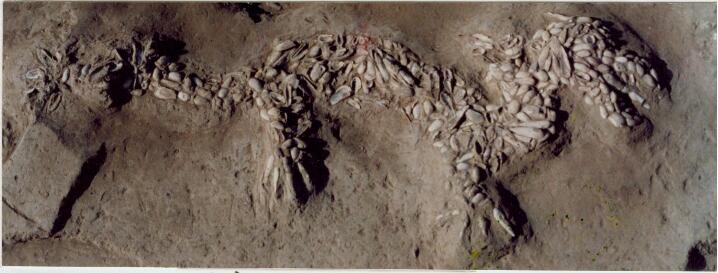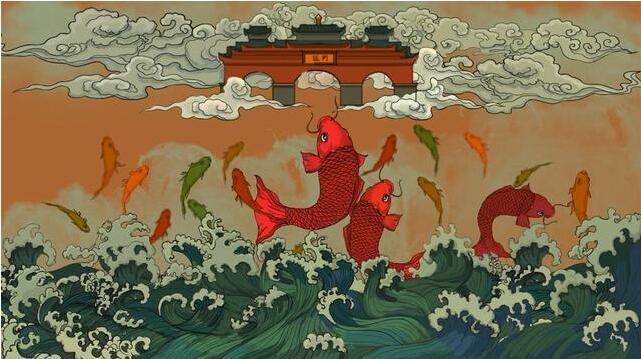
Zhengzhou Shanhai Callicarpa Museum
The Origin of "Fish Dragon" Pattern in Ancient Porcelain
Authors: Xu Bin and Zhou Yunxiang, executive vice presidents of Henan Collectors Association.
Among the porcelains collected by Zhengzhou Shanhaiji Museum, there is a Song Ruyao celadon bowl, and the bottom of the bowl is engraved with the "fish-shaped dragon" with a dragon head. So why did the ancestors carve this logo pattern in the bowl? What's the moral?

In the long-standing Chinese civilization and culture, dragons have an important position and influence. From the Neolithic Age, more than 7,000 years ago, the ancestors worshipped the dragon totem, and today people still use idioms or allusions with dragon characters to describe the beautiful things in life, such as: dragon horse spirit, dragon flying and phoenix dancing, carving dragons and painting phoenix, dragons and phoenixes, dragons and phoenixes, and so on.
In 1987, it was located in Yangshao Cultural Site in Shuipo, the west of Puyang County, Henan Province. On the left and right sides of the skeleton of a mature man in the middle of a tomb, the dragon and tiger patterns were carefully placed with mussels. The dragon patterns were 1.78 meters long and 0.67 meters high, with their heads held high, their bows bowed, their tails long, their forepaws raked and their hind paws pedaled, making them take off. It was designated as "the first Yi Long in China" by archaeologists. For thousands of years, the mythical dragon has penetrated all aspects of China society and become a kind of cultural cohesion and accumulation. The dragon has become a symbol of China, the Chinese nation and Chinese culture. Such titles as "descendants of the dragon" and "descendants of the dragon" often make us excited and proud, and at the same time gain the recognition of the world.

In the traditional porcelain making, every worker must have a picture, and every picture must be intentional. There are many different kinds of patterns, each of which has different meanings. Among many porcelain patterns, there is a kind of "fish dragon" pattern on the celadon plate in Song Dynasty, which is deeply loved by people. The pattern of the dragon head is printed on the inner bottom of the plate, which is lively and lifelike. So what is the origin and meaning of this "fish dragon" pattern?
About the beginning of Qin Shihuang's feudal dynasty, the dragon became the emperor's monopoly. Only the emperor could wear a "dragon robe", sit in a "dragon chair" and sleep in a "dragon bed" and pretend to be the real dragon emperor. In the seventh year of Emperor Kai in Sui Dynasty, Emperor Wendi of Sui Dynasty ordered the abolition of the nine-grade system of selecting officials according to their rank since Wei and Jin Dynasties, and began to set up departments to select officials. After the continuous improvement of emperors in Sui and Tang Dynasties, the imperial examination system was finally established. The so-called "ten years of cold window, no one asked, and became famous in one fell swoop." Poor students' efforts for many years, once won, are regarded as yue longmen.
The legend of "yue longmen the Carp" is still circulating in Longmen, Luoyang, Henan Province. Carps in the Yellow River can be transformed into dragons by jumping over the Longmen. It is said that a long time ago, Longmen was not dug, and the water was blocked by Longmen Mountain and accumulated into a lake in the south of the mountain. Carps in the Yellow River heard that Longmen was a beautiful place, so they wanted to take a trip. They struggled to swim to the Longmen Gate, and because there was no waterway on the Longmen, the carp gathered at the foot of the Longmen Mountain. A red carp advocated jumping over the Longmen and volunteered to be the first to try. With all my strength, I jumped into the clouds for a long time. At this time, a mass of skyfire fell from the sky and burned the tail of the red carp. It endured the pain and continued to leap, and finally jumped over the Longmen and fell into the lake in Shannan, turning into a dragon. Li Bai, a great poet in the Tang Dynasty, once wrote a poem about it: "The Yellow River three-foot carp originally lived in Mengjin. If you don't count your forehead, you will come back with all the fish. "

The pattern of "fish dragon" is a traditional auspicious pattern in China. It is a dragon with a dragon head and fish body, and it is also a form of "dragon-fish mutual change". This form has long existed in ancient China and evolved from folk customs and legends of past dynasties. It has a long history and can be traced back to the prehistoric Yangshao culture-fish totem worship in Banpo type period. It has been in use since the Tang Dynasty, especially in porcelain in the Song Dynasty and the Ming and Qing Dynasties. It is still circulating among the people in China that they hope their children can jump into the dragon gate and change their destiny through learning and their own efforts. "Dragon Gate" means a major turning point in life, such as the imperial examination and career promotion. It is a sign that people are to be no.1, proud of their official career and successful in official career.

Follow official account